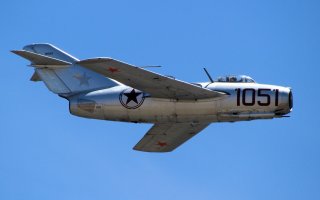U.S. Navy Fighters Once Battled Soviet MiGs Over North Korea
Soviet pilots harried U.N. forces using MiG-15 jets based across the Yalu River in China.
Panther Begets Cougar
The Panther’s relative lack of speed led Grumman to experiment with two reengined Panther variants: the F9F-4 mounted an Allison J-33, while the F-5 used the Rolls-Royce Tay, which mustered seven thousand pounds of thrust. Once again the British engine proved superior, boosting the Panther’s speed to 625 miles per hour and increasing maximum takeoff weight by 75 percent. Most F-4s were converted to F-5s.
The F9F-5 also boasted a new radar-ranging gunsight, a stretched fuselage to carry more fuel and a taller tail fin for improved low-speed handling. Grumman also experimented with producing Panthers with bare-metal finish, but these proved less resilient to corrosion.
The first of the improved Panthers made it to Korea late in 1952—just in time to participate in the Navy’s last great air battle of the war. In incident that remained classified until the fall of the Soviet Union, the F9F-5 piloted by Royce Williams engaged seven Soviet MiG-15s flying out of Vladivostok during a flurrying Siberian snow storm November 18.
Only three Soviet pilots made it back to base intact. Williams barely managed to land his own plane using just his elevators. Pocked with 263 shell holes, it was pitched overboard, and the pilot was treated to whiskey with President Eisenhower—and told to keep the dogfight with Soviet forces on the down low.
The Navy still saw further potential in the Panther, so Grumman built a swept-wing version called the F9F-6 Cougar. The Cougar was a bit faster and could fly significantly higher, but had shorter range due to added weight. Though it did not see action in the Korean War, it replaced the Panther soon afterwards. Though the Cougar was adapted to carry the first Sidewinder air-to-air missiles and even tactical nuclear weapons, it never saw combat except for a few Marine TF-9J trainers used as Forward Air Controllers in the Vietnam War.
Oddly, the Panther had one more battle to fight. Twenty-eight were transferred to the Argentine Navy in 1958. On April 2, 1963, a hard-line faction within the Navy attempted to overthrow the sitting government. When the Army dispatched the Eighth Tank Regiment to seize the naval air station at Punta Indio, the Panthers based there strafed and bombed the Sherman tanks, knocking out several but losing one Panther to .50 caliber machine-gun fire. Punto Indio fell the next day.
The Panther may not have been the top jet fighter of its time, but its pilots matched skill and courage to the gleaming blue jet’s sheer reliability and survivability to carve out a remarkable record in aviation history.
Sébastien Roblin holds a Master’s Degree in Conflict Resolution from Georgetown University and served as a university instructor for the Peace Corps in China. He has also worked in education, editing, and refugee resettlement in France and the United States. He currently writes on security and military history for War Is Boring.
This article first appeared in 2018.
Image: Flickr

